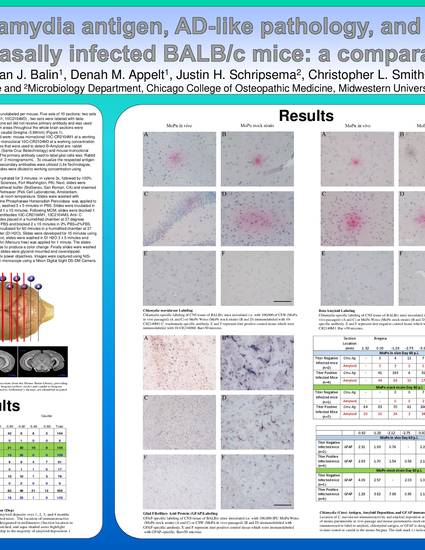
Background and Significance: Alzheimer’s Disease (AD) is characterized by amyloid deposition and inflammation. Chlamydia pneumoniae (Cpn) intranasal infection of BALB/c mice has been shown to induce AD like pathology in brain tissue. Preliminary data suggests that other species of Chlamydia induce similar pathology in mice. Objectives: (1) identify and localize Chlamydia antigen and amyloid pathology in specific AD-related brain regions of intranasally inoculated BALB/c mice infected with Cpn or Chlamydia muridarum (Cmu) and (2) evaluate the degree of glial cell activation in these regions. Methods: Non-transgenic BALB/c mice were intranasally inoculated with Cpn AR-39 (n=3) or Cmu (in vivo passaged Cmu (n=6) or stock Cmu (n=8). Brain tissues were examined at day 60 for chlamydia specific labeling, amyloid pathology and glial cell activation using immunohistochemistry. Results: At day 60, varying degrees of chlamydia and AD-like pathology were observed for both passaged Cmu and stock Cmu groups . Both groups had much higher antigen burden amyloid burden relative to titer negative mice. Glial cell activation was readily apparent in the brain where chlamydia and amyloid pathology had previously been localized. Cpn infected mice also displayed greater antigen burden and amyloid burden relative to titer negative mice which was consistent with Cmu findings . Conclusion: Mice with established Cmu infection were at greater risk for developing AD-like pathology. Activated glial cells in the Cmu infected brain tissues of both groups may be responsible for induction of AD like pathology. These data suggest that intranasal infection with Chlamydia species induces inflammation and AD-like brain pathology.
Available at: http://works.bepress.com/c_little/16/
